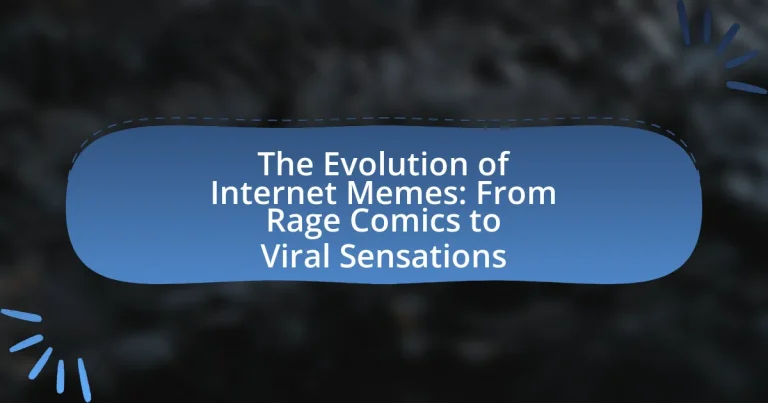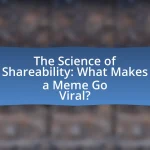The article examines the evolution of internet memes, tracing their origins from the 1990s to their current status as viral sensations. It defines internet memes as humorous images, videos, or text that convey cultural or social messages, highlighting their significance in shaping public discourse and community engagement. Key phases in meme evolution are outlined, including early text-based memes, image macros, and the rise of video memes, with a focus on how platforms like Reddit and social media have influenced meme trends. The article also discusses the characteristics of popular meme formats, their role in digital communication, and best practices for effective meme creation.
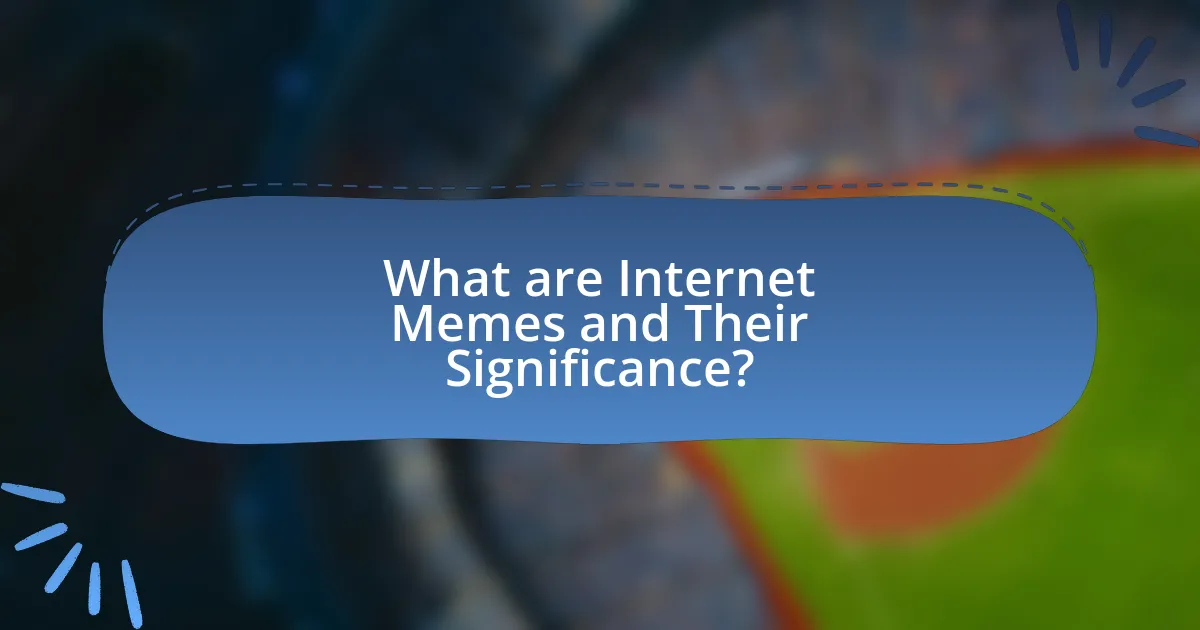
What are Internet Memes and Their Significance?
Internet memes are humorous images, videos, or text that are spread rapidly online, often modified by users to convey various cultural or social messages. Their significance lies in their ability to reflect and shape societal trends, opinions, and behaviors, serving as a form of digital communication that transcends language barriers. For instance, a study by Shifman (2014) in “Memes in Digital Culture” highlights how memes can influence public discourse and political movements, demonstrating their power in shaping narratives and fostering community engagement.
How did Internet Memes originate?
Internet memes originated from the early days of the internet, specifically in the 1990s, when users began sharing humorous images and phrases across forums and email chains. The term “meme” itself was coined by Richard Dawkins in his 1976 book “The Selfish Gene,” where he described it as an idea that spreads within a culture. The first recognizable internet memes included the “Dancing Baby” and “All Your Base Are Belong to Us,” which gained popularity through email and early websites. These early memes laid the groundwork for the rapid evolution of meme culture, facilitated by social media platforms in the 2000s, allowing for widespread sharing and remixing of content.
What cultural factors contributed to the rise of Internet Memes?
Cultural factors that contributed to the rise of Internet memes include the proliferation of social media platforms, the democratization of content creation, and the influence of youth culture. Social media platforms like Facebook, Twitter, and Instagram enabled rapid sharing and dissemination of memes, allowing them to reach a global audience quickly. The democratization of content creation empowered individuals to produce and share their own humorous or relatable content, leading to a diverse array of memes. Additionally, youth culture, characterized by a preference for humor, irony, and self-expression, played a significant role in meme creation and popularity, as younger generations often use memes as a form of communication and social commentary.
How did early memes differ from modern ones?
Early memes primarily consisted of simple images with text, often relying on humor and cultural references, while modern memes utilize advanced multimedia formats, including videos, GIFs, and interactive content. Early memes, such as Rage Comics, were typically static and shared on forums or social media platforms like 4chan and Reddit, whereas modern memes are often dynamic, leveraging platforms like TikTok and Instagram for rapid dissemination and engagement. The evolution reflects a shift from niche communities to widespread viral trends, with modern memes often incorporating sophisticated editing techniques and broader cultural commentary, making them more relatable and shareable across diverse audiences.
Why are Internet Memes important in digital communication?
Internet memes are important in digital communication because they serve as a concise and relatable means of expressing ideas, emotions, and cultural commentary. Memes facilitate rapid information sharing and engagement, often transcending language barriers, which enhances their effectiveness in conveying messages. For instance, a study by Shifman (2014) in “Memes in Digital Culture” highlights how memes can encapsulate complex social issues in a humorous or satirical format, making them more accessible and shareable among diverse audiences. This ability to distill and disseminate information quickly contributes to their significance in shaping online discourse and community interactions.
How do memes influence social interactions online?
Memes significantly influence social interactions online by serving as a form of communication that transcends language barriers and cultural differences. They facilitate shared understanding and emotional connections among users, often leading to increased engagement and community building. For instance, a study published in the journal “Computers in Human Behavior” found that memes can enhance social bonding by allowing individuals to express humor and relatability, which fosters a sense of belonging within online communities. Additionally, memes often act as social commentary, enabling users to discuss and critique societal issues in a more approachable manner, thus shaping public discourse and collective identity.
What role do memes play in shaping public opinion?
Memes significantly influence public opinion by simplifying complex ideas into relatable and shareable content. They serve as a vehicle for social commentary, allowing individuals to express their views on political, cultural, and social issues in a humorous or satirical manner. Research indicates that memes can enhance the spread of information, as they are easily digestible and often go viral, reaching wide audiences quickly. For instance, during the 2016 U.S. presidential election, memes played a crucial role in shaping perceptions of candidates, with studies showing that meme engagement correlated with shifts in voter sentiment. This demonstrates that memes not only reflect public opinion but actively contribute to its formation and evolution.
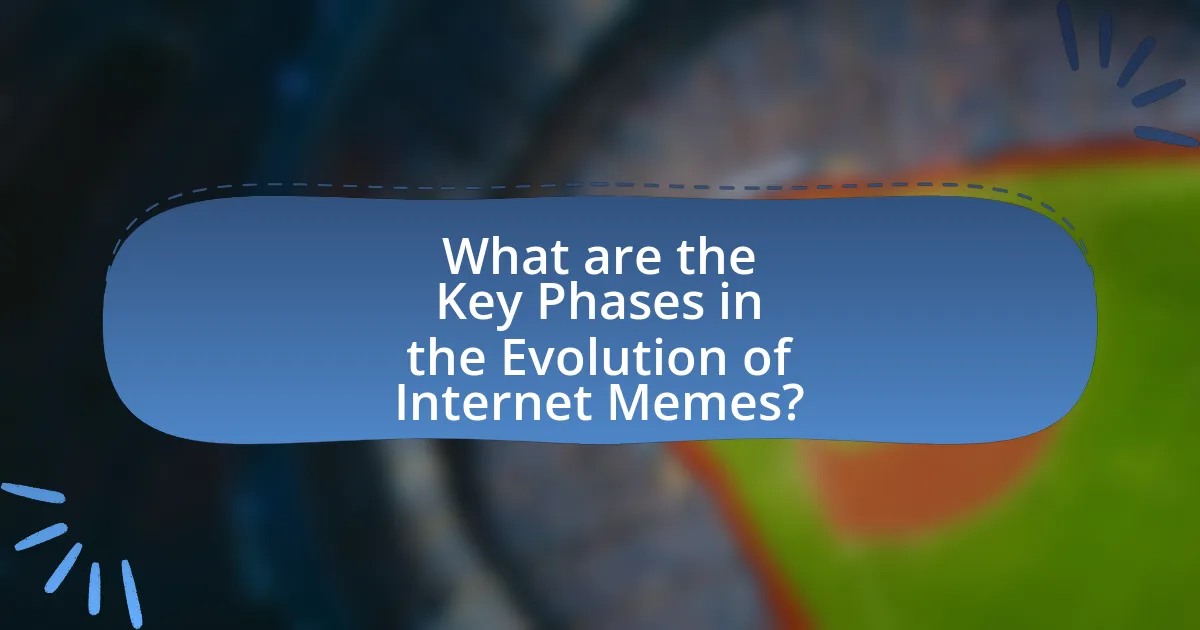
What are the Key Phases in the Evolution of Internet Memes?
The key phases in the evolution of internet memes include the early text-based memes, image macros, viral videos, and the rise of social media platforms. Initially, memes like “Rage Comics” emerged in the early 2000s, characterized by simple drawings and relatable humor. This phase transitioned into image macros, where images with humorous text overlays became popular, exemplified by memes like “Bad Luck Brian” and “Success Kid.” The advent of platforms like YouTube in the mid-2000s facilitated the spread of viral videos, which became a significant meme format. Finally, the rise of social media platforms such as Facebook, Twitter, and Instagram in the 2010s allowed for rapid sharing and remixing of memes, leading to the creation of trends like “Distracted Boyfriend” and “Woman Yelling at a Cat.” Each phase reflects technological advancements and shifts in user engagement, demonstrating how internet memes have adapted over time.
How did Rage Comics set the stage for future memes?
Rage Comics established a foundational framework for future memes by popularizing the use of simple, relatable characters and exaggerated expressions to convey emotions and reactions. This format allowed users to easily create and share content that resonated with a wide audience, fostering a culture of rapid meme generation and adaptation. The distinct visual style and humor of Rage Comics influenced subsequent meme formats, such as image macros and reaction GIFs, which similarly rely on visual simplicity and emotional relatability. As a result, Rage Comics played a crucial role in shaping the meme landscape, paving the way for the diverse and viral nature of modern internet memes.
What characteristics defined Rage Comics?
Rage Comics are characterized by their simplistic art style, often featuring hand-drawn characters with exaggerated facial expressions and emotions. These comics typically depict relatable scenarios that evoke strong emotional responses, particularly frustration or anger, which is reflected in the characters’ expressions. The use of recurring characters, such as “Forever Alone” and “Y U NO Guy,” adds to their appeal and recognizability. Additionally, Rage Comics often employ a straightforward narrative structure, making them easy to understand and share, contributing to their viral nature on platforms like Reddit and 4chan.
How did Rage Comics reflect internet culture at the time?
Rage Comics reflected internet culture by encapsulating the humor, frustrations, and shared experiences of online communities during the early 2010s. These comics utilized simple, exaggerated facial expressions and relatable scenarios, which resonated with users navigating the complexities of digital communication and social interactions. The widespread use of Rage Comics on platforms like Reddit and 4chan demonstrated a collective understanding of memes as a form of expression, allowing users to convey emotions and reactions succinctly. This format contributed to the rise of meme culture, emphasizing the importance of visual storytelling in online discourse.
What were the major milestones in meme evolution?
The major milestones in meme evolution include the emergence of early internet memes in the late 1990s, the rise of image macros in the 2000s, the popularity of social media platforms in the 2010s, and the transition to video memes in the late 2010s. Early internet memes, such as “Dancing Baby,” set the foundation for meme culture. Image macros, characterized by humorous text overlaid on images, became widespread with platforms like 4chan and Reddit. The advent of social media, particularly Facebook and Twitter, facilitated rapid sharing and viral spread of memes. Finally, the late 2010s saw the rise of video memes, exemplified by formats like TikTok, which transformed how memes are created and consumed. Each of these milestones reflects significant shifts in technology and user engagement, shaping the landscape of internet culture.
How did platforms like Reddit and 4chan influence meme trends?
Platforms like Reddit and 4chan significantly influenced meme trends by serving as breeding grounds for viral content and community-driven humor. Reddit’s upvote system allows popular memes to gain visibility quickly, while 4chan’s anonymous posting encourages raw, unfiltered creativity, leading to the rapid spread of niche memes. For instance, the “Pepe the Frog” meme originated on 4chan and became a cultural phenomenon, illustrating how these platforms can elevate specific images or phrases to widespread recognition. Additionally, both platforms fostered unique subcultures that shaped the types of humor and themes prevalent in memes, such as absurdism and irony, further driving the evolution of internet memes.
What impact did social media have on meme dissemination?
Social media significantly accelerated meme dissemination by providing platforms for rapid sharing and engagement. The viral nature of social media allows memes to reach vast audiences almost instantaneously, as evidenced by the fact that platforms like Twitter and Instagram can amplify a meme’s visibility through likes, shares, and retweets. For instance, the “Distracted Boyfriend” meme gained widespread popularity within days of its creation, largely due to its circulation on social media channels. This rapid spread is facilitated by algorithms that prioritize engaging content, further enhancing the reach and impact of memes in contemporary digital culture.
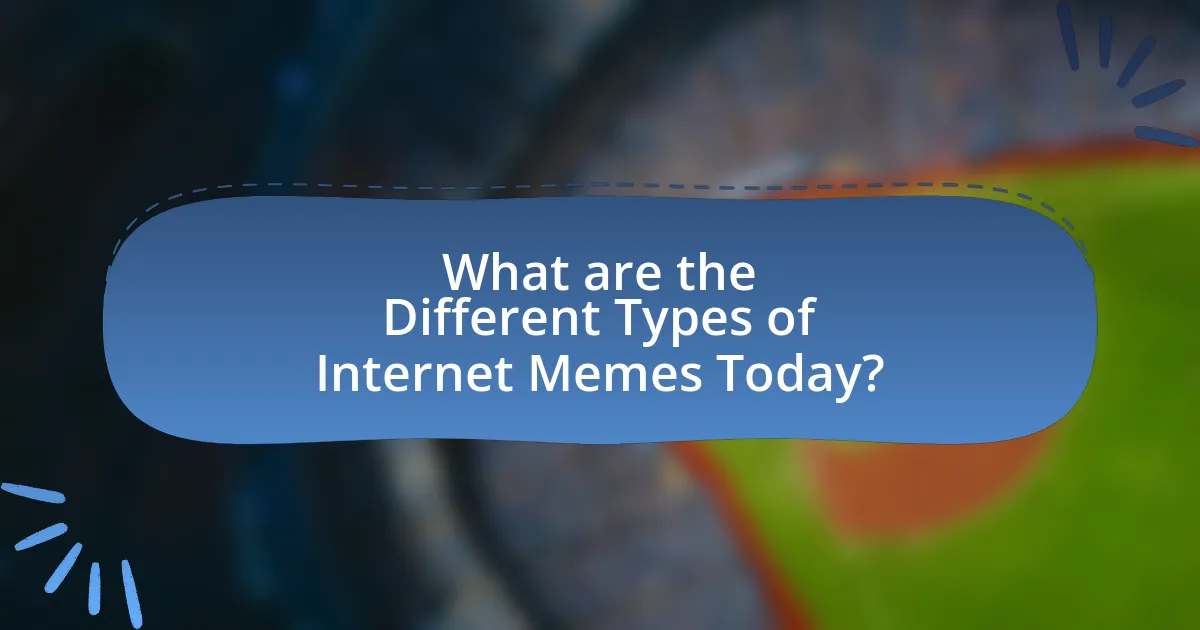
What are the Different Types of Internet Memes Today?
The different types of internet memes today include image macros, GIFs, video memes, and text-based memes. Image macros typically consist of a picture with humorous text overlay, often conveying relatable emotions or situations. GIFs are short, looping animations that capture funny or poignant moments, frequently used in social media conversations. Video memes, which can be clips from movies, shows, or user-generated content, often go viral due to their comedic or absurd nature. Text-based memes, such as copypasta or memes that rely solely on text, convey humor through written content and are often shared in forums or social media. Each type reflects the evolving nature of internet culture and communication, adapting to platforms and user preferences.
How do image macros differ from GIFs and videos?
Image macros differ from GIFs and videos primarily in their format and content delivery. Image macros are static images, often featuring a combination of a picture and text, designed to convey humor or commentary quickly. In contrast, GIFs are short, looping animations that can capture motion and express emotions or reactions, while videos are longer, dynamic sequences that provide more extensive storytelling or information. The distinct characteristics of image macros, such as their simplicity and immediacy, allow for rapid sharing and comprehension, making them a popular choice in meme culture.
What are the defining features of image macros?
Image macros are defined by their combination of a visual image and overlaid text, typically conveying humor or commentary. These features include a clear, often humorous message that is easily understood, a recognizable image that serves as a backdrop, and a format that allows for quick sharing and adaptation across various platforms. The use of bold, legible fonts enhances readability, while the simplicity of the design facilitates rapid comprehension, making them effective for viral dissemination. Image macros have become a staple in internet culture, exemplified by popular formats like the “Distracted Boyfriend” meme, which showcases how a single image can be repurposed with different text to convey diverse meanings.
How have GIFs and videos transformed meme formats?
GIFs and videos have transformed meme formats by enabling dynamic and engaging content that enhances emotional expression and storytelling. Unlike static images, GIFs provide a looped animation that captures attention and conveys humor or emotion more effectively, while videos allow for longer narratives and richer context. For instance, the rise of platforms like Vine and TikTok has popularized short video memes, which can quickly go viral due to their shareability and relatability. This shift has led to a more diverse range of meme formats, as users can now combine visuals, sound, and text to create multifaceted expressions that resonate with audiences, thereby increasing the overall impact and reach of memes in digital culture.
What are some popular meme formats currently trending?
Some popular meme formats currently trending include the “Distracted Boyfriend,” “Woman Yelling at a Cat,” and “Expanding Brain.” The “Distracted Boyfriend” format depicts a man looking at another woman while his girlfriend looks on disapprovingly, often used to illustrate conflicting desires. The “Woman Yelling at a Cat” features a woman shouting and a confused cat sitting at a table, commonly used to express frustration or absurdity. The “Expanding Brain” format showcases a series of images representing increasing levels of intelligence or enlightenment, often humorously juxtaposing simple ideas with more complex ones. These formats have gained traction on social media platforms like Instagram and Twitter, reflecting current cultural conversations and humor trends.
How do these formats reflect current societal issues?
Internet meme formats reflect current societal issues by serving as a medium for commentary on cultural, political, and social dynamics. For instance, memes often address topics such as mental health, social justice, and political polarization, illustrating public sentiment and collective experiences. A notable example is the widespread use of memes during the COVID-19 pandemic, which highlighted issues like misinformation and public health responses, as seen in the viral “Distracted Boyfriend” meme that critiqued societal priorities. This demonstrates how meme formats encapsulate and amplify societal concerns, making complex issues more accessible and relatable to a broad audience.
What makes a meme go viral in today’s digital landscape?
A meme goes viral in today’s digital landscape primarily due to its relatability, shareability, and emotional resonance. Relatable content connects with a wide audience, making individuals feel understood or represented. Shareability is enhanced by the meme’s format, which often encourages easy sharing across social media platforms. Emotional resonance, whether through humor, nostalgia, or shock, drives engagement and prompts users to share the meme with their networks. For instance, a study by the University of Pennsylvania found that memes that evoke strong emotional responses are 20% more likely to be shared, highlighting the importance of emotional impact in virality.
What are best practices for creating effective Internet Memes?
To create effective Internet memes, focus on relatability, humor, and simplicity. Memes that resonate with a wide audience often incorporate current events or popular culture references, making them more shareable. Additionally, using clear and concise text enhances understanding, while visually appealing images capture attention. Research indicates that memes with a strong emotional appeal, such as humor or nostalgia, are more likely to go viral, as they evoke a response that encourages sharing.
How can understanding meme culture enhance meme creation?
Understanding meme culture enhances meme creation by providing insights into the social dynamics, humor, and trends that resonate with audiences. This knowledge allows creators to craft content that aligns with current cultural references and shared experiences, increasing the likelihood of engagement and virality. For instance, memes often draw on popular media, internet trends, and collective sentiments, which can be effectively utilized by creators who are attuned to these elements. Research indicates that memes that reflect timely cultural moments or utilize recognizable formats tend to achieve higher levels of sharing and interaction, demonstrating the importance of cultural awareness in successful meme creation.
What tools and platforms are best for meme creation and sharing?
The best tools and platforms for meme creation and sharing include Canva, Imgflip, and Giphy. Canva offers a user-friendly interface with customizable templates, allowing users to create visually appealing memes quickly. Imgflip provides a meme generator that features popular meme formats and allows for easy sharing across social media platforms. Giphy specializes in animated GIFs, enabling users to create and share dynamic memes. These platforms are widely used due to their accessibility and the ability to reach large audiences, making them effective for meme dissemination.
